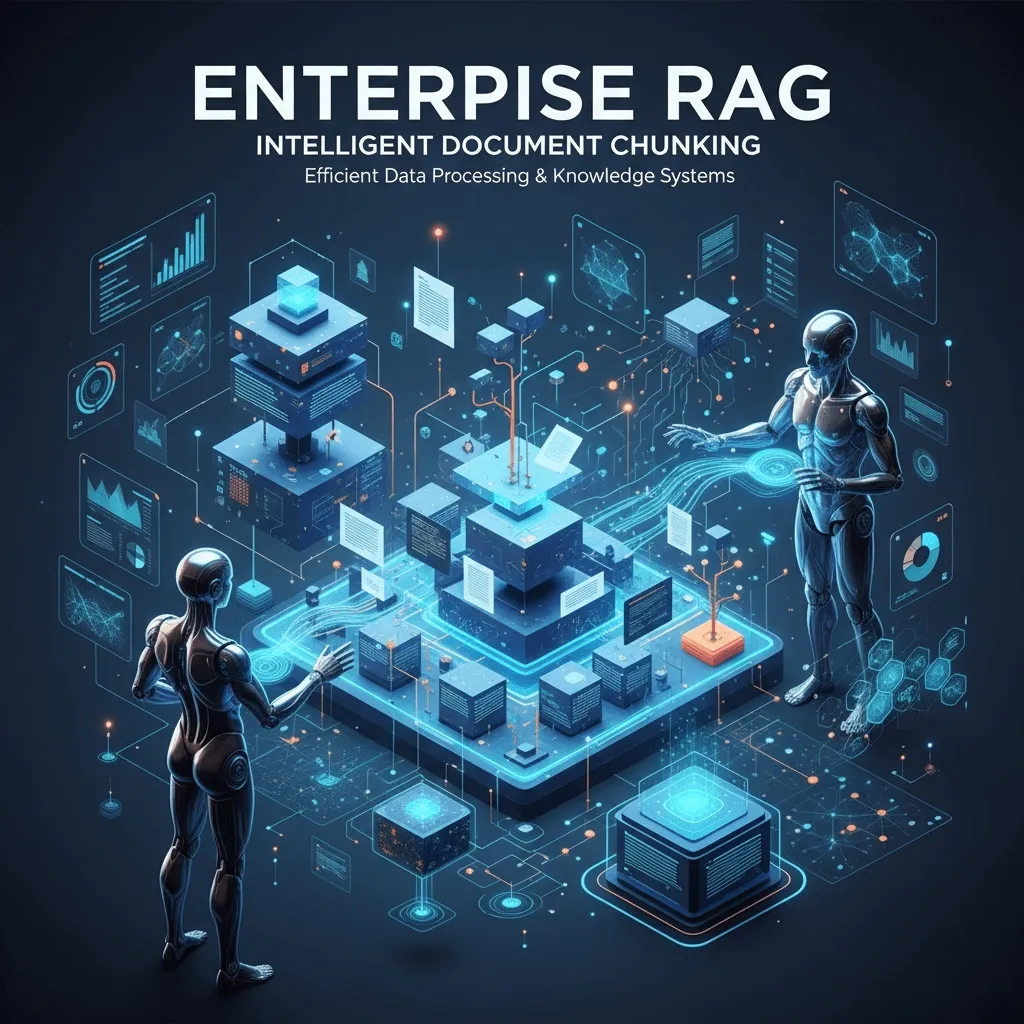Enterprise RAG Crisis: Tencent HiChunk Breakthrough


The Silent Crisis Breaking Your Enterprise AI
You’ve invested hundreds of thousands of dollars in enterprise AI systems. Your team has carefully selected the best language models, built sophisticated Retrieval-Augmented Generation (RAG) pipelines, and fed them your company’s most valuable documents. Yet when you ask for a comprehensive analysis of your 100-page financial report, the AI gives you fragmented, disjointed answers that miss critical connections between related information.
The risk mentioned on page 12? Your AI found it. The mitigation strategy detailed on page 78? Somehow missed entirely. The quarterly projections that depend on both pieces of information? Incomplete and potentially misleading.
This isn’t a failure of your language model’s reasoning capabilities. It’s not a problem with your vector database or retrieval algorithms. The crisis lies in something far more fundamental—and until recently, largely ignored: how your documents get chunked before they ever reach your AI.
Welcome to the chunking crisis, enterprise AI’s most overlooked bottleneck. And according to groundbreaking new research from Tencent YouTu Lab, it’s been sabotaging your AI investments in ways you never realized.
Why Traditional Chunking Is Killing Your ROI
Every RAG system follows the same basic workflow: break documents into smaller pieces (chunks), convert them to embeddings, store them in a vector database, and retrieve relevant chunks when answering questions. It sounds straightforward, but the devil is in the details—specifically, in how those chunks are created.
Traditional chunking approaches treat documents like novels, breaking them at arbitrary word counts or sentence boundaries. A 500-word chunk might contain the first half of a crucial financial analysis, while the second half—with the actual conclusions—ends up in a completely different chunk with different embedding vectors. When your AI searches for relevant information, it might retrieve one piece but miss the other, leading to incomplete or misleading answers.
The problem compounds in enterprise environments where documents are complex, hierarchical, and interdependent. Financial reports, legal contracts, technical specifications, and strategic plans aren’t linear narratives. They’re sophisticated structures where headings, sections, and subsections create meaningful relationships between different pieces of information.
Traditional chunking destroys these relationships. It’s like taking apart a carefully assembled machine and expecting the individual parts to still function properly.
The HiChunk Breakthrough: Thinking in Hierarchies
Tencent’s HiChunk (Hierarchical Chunking) represents a fundamental rethinking of how enterprise documents should be processed for AI systems. Instead of blindly cutting documents at arbitrary boundaries, HiChunk understands document structure and preserves the hierarchical relationships that make information meaningful.
The innovation centers on two key insights:
Document Hierarchy Matters: Real enterprise documents are organized hierarchically—sections contain subsections, which contain paragraphs, which contain specific details. HiChunk preserves these relationships by creating chunks that respect document structure rather than ignoring it.
Context Preservation: Instead of creating isolated chunks that lose their relationship to surrounding content, HiChunk maintains contextual connections. When the AI retrieves information about quarterly projections, it can also access related risk assessments and mitigation strategies because the chunking process preserved these relationships.
The results are striking. In Tencent’s benchmarks using their new HiCBench evaluation framework, HiChunk consistently outperformed traditional chunking methods across multiple enterprise use cases, with particularly impressive improvements in complex, multi-section document analysis.
Real-World Impact: Where HiChunk Changes Everything
The implications extend far beyond academic benchmarks. Consider these enterprise scenarios where hierarchical chunking delivers transformative improvements:
Financial Analysis: When analyzing annual reports, traditional chunking might separate executive summaries from supporting financial data. HiChunk ensures that high-level insights remain connected to their underlying evidence, enabling more comprehensive and accurate financial analysis.
Legal Document Review: Contract analysis requires understanding how general terms relate to specific clauses and exceptions. HiChunk preserves these hierarchical relationships, allowing AI systems to provide more nuanced legal interpretations that consider both general principles and specific conditions.
Technical Documentation: Engineering specifications often have complex dependencies where design decisions in one section impact implementation details in another. HiChunk’s hierarchical approach ensures these connections remain intact, leading to better technical guidance and fewer misunderstandings.
Strategic Planning: Corporate strategy documents layer high-level objectives with detailed implementation plans. Traditional chunking fragments this relationship; HiChunk preserves it, enabling AI systems to provide strategic guidance that connects vision with execution.
The Technical Architecture: How HiChunk Works
HiChunk’s technical approach combines document structure analysis with intelligent boundary detection:
Structure Recognition: The system first analyzes document organization, identifying headings, sections, subsections, and other hierarchical elements. This creates a structural map that guides the chunking process.
Semantic Boundary Detection: Rather than cutting at arbitrary word counts, HiChunk identifies natural semantic boundaries where ideas complete and new concepts begin. This preserves conceptual integrity within chunks.
Hierarchical Embedding: The system creates embeddings that capture not just the content of individual chunks, but their position and relationships within the document hierarchy. This enables more sophisticated retrieval that considers structural context.
Multi-Level Retrieval: When answering questions, HiChunk can retrieve information at different hierarchical levels—from specific details to broader section summaries—depending on what the query requires.
Benchmarking the Breakthrough: HiCBench Results
Tencent didn’t just develop a new chunking method; they created HiCBench, the first comprehensive benchmark specifically designed to evaluate chunking approaches in enterprise contexts. The benchmark tests systems across multiple dimensions:
- Coherence: How well do retrieved chunks work together to provide complete answers?
- Completeness: Does the system find all relevant information, even when it’s spread across multiple sections?
- Context Preservation: Are hierarchical relationships maintained during retrieval?
- Accuracy: Do the final answers correctly represent the source material?
HiChunk consistently outperformed traditional methods across all dimensions, with particularly strong improvements in complex, multi-section queries that require understanding document structure.
Implementation Strategy: Getting HiChunk Right
Successfully implementing hierarchical chunking requires rethinking your entire RAG pipeline:
Document Analysis First: Before chunking any documents, invest in structure analysis. Understand how your enterprise documents are organized and where traditional chunking is likely to break important relationships.
Gradual Migration: Don’t rebuild your entire RAG system overnight. Start with your most critical document types—those where fragmented answers create the biggest business risks—and gradually expand to other content.
Quality Metrics: Traditional RAG metrics focus on retrieval accuracy and response time. With hierarchical chunking, you need new metrics that measure relationship preservation and contextual completeness.
User Training: Your teams need to understand how to craft queries that take advantage of hierarchical understanding. Questions that reference document structure (“What does the executive summary say about the risks mentioned in section 4?”) can leverage HiChunk’s full capabilities.
The Competitive Implications: Why Early Adoption Matters
The chunking crisis isn’t just a technical problem—it’s a competitive advantage waiting to be claimed. Organizations that solve this problem first will have AI systems that provide more complete, accurate, and useful insights from their enterprise data.
Consider the implications:
Better Decision Making: When your AI can provide complete, contextually rich analysis of complex documents, your leadership team makes better strategic decisions based on more comprehensive information.
Reduced Risk: Fragmented AI answers can lead to oversight of critical risks or opportunities. HiChunk’s comprehensive approach reduces these blind spots.
Competitive Intelligence: Better document analysis means better understanding of market conditions, competitor strategies, and industry trends.
Operational Efficiency: When your AI systems provide complete answers the first time, your teams spend less time hunting for missing information or second-guessing AI recommendations.
The Future of Enterprise Knowledge Systems
HiChunk represents more than just an incremental improvement in chunking techniques. It signals a broader shift toward AI systems that understand and preserve the complex information architectures that define enterprise knowledge.
As organizations generate increasingly complex documents—from multi-departmental strategic plans to comprehensive compliance frameworks—the ability to maintain contextual relationships becomes even more critical. The companies that master hierarchical approaches to enterprise AI will find themselves with sustainable competitive advantages in knowledge management and decision support.
The chunking crisis has been enterprise AI’s silent saboteur, destroying value through fragmented understanding and incomplete analysis. Tencent’s HiChunk breakthrough doesn’t just solve this problem—it transforms enterprise document analysis from a technical limitation into a competitive weapon.
The question isn’t whether hierarchical chunking will become standard in enterprise AI. The question is whether your organization will be ahead of or behind the curve when it does.
Frequently Asked Questions
What exactly is the “chunking crisis” in enterprise RAG systems?
The chunking crisis refers to the fundamental problem where traditional document chunking methods break up enterprise documents at arbitrary boundaries, destroying important hierarchical relationships and contextual connections. This leads to AI systems that provide fragmented, incomplete answers because they can’t access related information that was separated during the chunking process. For example, a risk assessment might be split from its corresponding mitigation strategy, leading to incomplete analysis.
How does Tencent’s HiChunk differ from traditional chunking approaches?
HiChunk (Hierarchical Chunking) analyzes document structure before chunking, preserving headings, sections, and subsections rather than cutting at arbitrary word counts. It creates chunks that respect semantic boundaries and maintains hierarchical relationships through specialized embedding techniques. This allows AI systems to understand how different pieces of information relate to each other within the document’s organizational structure, leading to more complete and contextually accurate responses.
What types of enterprise documents benefit most from hierarchical chunking?
Complex, structured enterprise documents see the greatest improvement: financial reports with executive summaries linked to detailed data, legal contracts with general terms and specific clauses, technical specifications with interdependent sections, strategic planning documents that layer objectives with implementation details, and compliance frameworks where policies connect to procedures. Any document where understanding relationships between sections is crucial for accurate analysis benefits significantly from HiChunk’s approach.
How can organizations measure the ROI of implementing hierarchical chunking?
ROI metrics for hierarchical chunking focus on answer quality and decision-making improvements: completeness scores measuring whether AI responses include all relevant information, relationship preservation metrics tracking how well contextual connections are maintained, decision accuracy improvements from more comprehensive analysis, reduced time spent on follow-up questions or information hunting, and decreased risk from overlooked critical information. Organizations typically see measurable improvements in knowledge worker productivity and strategic decision quality.
What are the implementation challenges for adopting HiChunk-style systems?
Key implementation challenges include: requiring document structure analysis capabilities that many existing RAG systems lack, needing new embedding approaches that capture hierarchical relationships, developing evaluation metrics beyond traditional retrieval accuracy, training teams to leverage hierarchical understanding in their queries, and potentially significant changes to existing RAG pipelines. However, the benefits of more complete and accurate AI analysis typically justify the implementation investment for organizations dealing with complex enterprise documents.